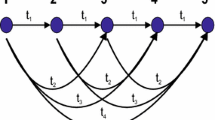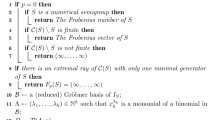Abstract
In this paper we construct a multiset S(f) of a Boolean function f consisting of the weights of the second derivatives of the function f with respect to all distinct two-dimensional subspaces of the domain. We refer to S(f) as the second derivative spectrum of f. The frequency distribution of the weights of these second derivatives is referred to as the weight distribution of the second derivative spectrum. It is demonstrated in this paper that this weight distribution can be used to distinguish affine nonequivalent Boolean functions. Given a Boolean function f on n variables we present an efficient algorithm having O(n22n) time complexity to compute S(f). Using this weight distribution we show that all the 6-variable affine nonequivalent bents can be distinguished. We study the subclass of partial-spreads type bent functions known as PS ap type bents. Six different weight distributions are obtained from the set of PS ap bents on 8-variables. Using the second derivative spectrum we show that there exist 6 and 8 variable bent functions which are not affine equivalent to rotation symmetric bent functions. Lastly we prove that no non-quadratic Kasami bent function is affine equivalent to Maiorana–MacFarland type bent functions.
Similar content being viewed by others
References
Armknecht F, Carlet C, Gaborit P, Künzli S, Meier W, Ruatta O (2006) Efficient computation of algebraic immunity for algebraic and fast algebraic attacks, EUROCRYPT. Lect Notes Comput Sci 4004: 147–164
Braeken A, Borisov Y, Nikova S, Preneel B (2005) Classification of boolean functions of 6 variables or less with respect to cryptographic properties. International colloquium on automata, languages and programming ICALP 2005. Lecture notes in computer science, vol 3580. Springer, Heidelberg, pp 324–334
Canteaut A, Charpin P (2003) Decomposing bent functions. IEEE Trans Inf Theory 49(8): 2004–2019
Canteaut A, Daum M, Dobbertin H, Leander G (2006) Finding nonnormal bent functions. Discrete Appl Math 154: 202–218
Carlet C (1992) Partially-bent functions Crypto’92. Lect Notes Comput Sci 740: 280–291
Carlet C (1994) Two new classes of bent functions Eurocrypt’93. Lect Notes Comput Sci 765: 77–101
Dillon JF (1974) Elementary hadamard difference sets. Ph.D. Thesis, University of Maryland
Dillon JF (1975) Elementary Hadamard difference sets. In: Proceedings of 6th S. E. Conference of combinatorics, graph theory, and computing. Utility Mathematics, Winnipeg, pp 237–249
Dillon JF, Dobbertin H (2008) New cyclic difference sets with Singer parameters. Finite Fields Appl 10: 342–389
Dobbertin H (1995) Construction of bent functions and highly nonlinear balanced Boolean functions. FSE 1994 Lecture Notes in Computer Science, vol 1008, pp 61–74
Dobbertin H, Leander G (2005) A survey of some recent results on bent functions. SETA Lect Notes Comput Sci 3486: 1–29
Gangopadhyay S, Sharma D, Sarkar S, Maitra S (2008) On affine (non)equivalence of bent functions. In: 8th central european conference on cryptography (CECC08). Graz, Austria, pp 13–15
Sharma D, Gangopadhyay S (2008) On Kasami bent functions. Cryptology ePrint Archive, report 2008/426
Hou XD (1996) GL(m,2) acting on R(r,m)/R(r−1,m). Discrete Math 149: 99–122
Hou XD (1998) Cubic bent functions. Discrete Math 189: 149–161
MacWilliams FJ, Sloane NJA (1977) The theory of error correcting codes. North-Holland, Amsterdam
Meng Q, Yang M, Zhang H, Liu Y (2005) Analysis of affinely equivalent boolean functions. First International Workshop, BFCA’05 105–114
Lidl R, Niederreiter H (1994) Introduction to finite fields and their applications. Cambridge University Press, London
Preneel B (1993) Analysis and design of cryptographic hash functions. Ph.D. thesis, Katholieke Universiteit Leuven
Rothaus OS (1976) On bent functions. J Comb Theory Ser A 20: 300–305
Stanica P, Maitra S (2002) Rotation symmetric Boolean functions—count and cryptographic properties. In: Bose RC (ed) Centenary symposium on discrete mathematics and applications. Electronic Notes in Discrete Mathematics, vol 15. Elsevier, Amsterdam
Author information
Authors and Affiliations
Corresponding author
Additional information
This paper is based on [12] and [13].
Rights and permissions
About this article
Cite this article
Gangopadhyay, S., Sharma, D., Sarkar, S. et al. On affine (non)equivalence of Boolean functions. Computing 85, 37–55 (2009). https://doi.org/10.1007/s00607-009-0041-z
Received:
Accepted:
Published:
Issue Date:
DOI: https://doi.org/10.1007/s00607-009-0041-z




